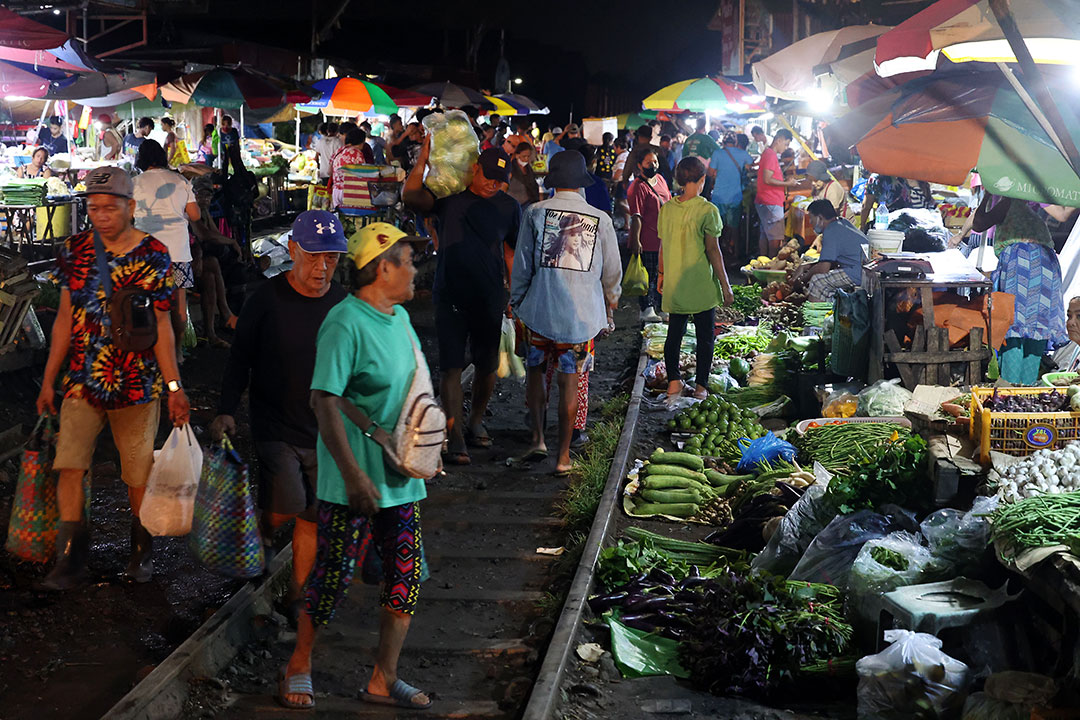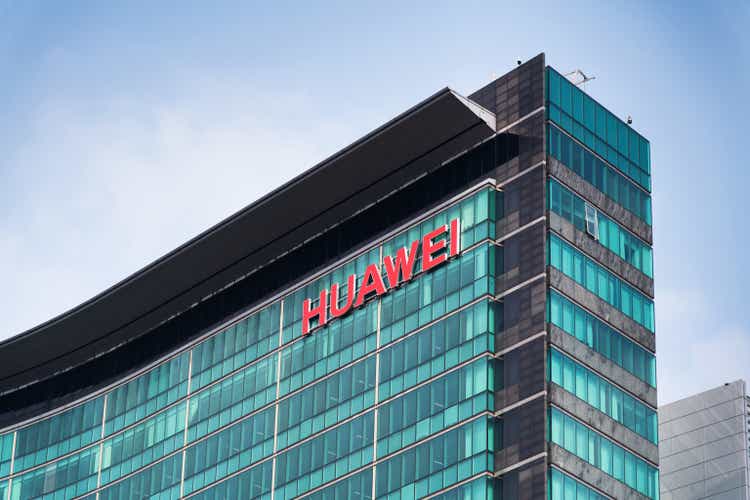 Vendors sell vegetables and other produce at a market along the Philippine National Railways (PNR) tracks in Calamba, Laguna, June 2, 2023. — PHILIPPINE STAR/MIGUEL DE GUZMAN
Vendors sell vegetables and other produce at a market along the Philippine National Railways (PNR) tracks in Calamba, Laguna, June 2, 2023. — PHILIPPINE STAR/MIGUEL DE GUZMANBy Luisa Maria Jacinta C. Jocson, Senior Reporter
HEADLINE INFLATION likely slowed further in May to another over five-year low amid the continued decline in food prices and a stronger peso.
A BusinessWorld poll of 17 analysts conducted last week yielded a median estimate of 1.3% for the May consumer price index (CPI), slower than the 1.4% in April and 3.9% in the same month a year ago. This is within the Bangko Sentral ng Pilipinas’ (BSP) 0.9%-1.7% forecast for the month.
If realized, this would be the lowest clip in more than five years or since the 1.2% in November 2019.
The Philippine Statistics Authority is scheduled to release May inflation data on Thursday (June 5).
“We expect May inflation to have eased slightly to 1.3% year on year from 1.4% in April, implying a month-on-month decline of 0.1%,” Bank of the Philippine Islands Lead Economist Emilio S. Neri, Jr. said.
“The sustained drop in rice prices, coupled with lower energy and fuel costs, remained the primary drivers of disinflation,” he said.
Emmanuel J. Lopez, professorial lecturer at the University of Santo Tomas Graduate School, said inflation likely eased to 1.3% “owing to lower prices of food and agricultural products and lower transport costs.”
“This is added to the continued appreciation of the peso against the US dollar resulting in the cheaper price of imported products,” he added.
Sun Life Investment Management and Trust Corp. economist Patrick M. Ella said slower inflation in May is likely due to “favorable food prices decelerating and stable nonfood prices similar to the past two months.”
“The sustained fall in rice prices and decline in cost of oil likely kept inflation below the BSP’s 2-4% target,” Philippine National Bank economist Alvin Joseph A. Arogo added.
In April, rice inflation further contracted to 10.9% from the 7.7% decline in March.
Latest data showed the average price of a kilo of regular milled rice nationwide declined by 13.3% year on year to P44.45 in April, while well-milled rice dropped by 10.4% to P50.54. Special rice went down by 6.2% to P60.69 per kilo.
“Food supply is expected to have improved compared to a year earlier due to better weather conditions, supporting better harvests. This should feed into stable retail price growth,” Moody’s Analytics economist Sarah Tan said.
“As for utilities, power rates were lowered in May, which will provide relief to households and businesses,” Ms. Tan added.
After three months of straight hikes, Manila Electric Co. lowered the overall rate for May by P0.7499 per kilowatt-hour (kWh) to P12.2628 per kWh from P13.0127 per kWh in April.
The strong peso and lower global oil prices have lowered energy costs, said Aris D. Dacanay, economist for ASEAN at HSBC Global Research.
The peso closed at P55.745 per dollar at end-May, strengthening by 9.5 centavos from the P55.84 finish at end-April.
On the other hand, Chinabank Research flagged price pressures from key food items such as meat, vegetables, fruits, and eggs, though said these could have been offset by the monthly decreases in prices of rice, fish, sugar, electricity and liquefied petroleum gas.
Nicholas Antonio T. Mapa, chief economist at Metropolitan Bank & Trust Co., said upward pressure from meat prices and utility costs may have nudged the headline inflation rate higher last month.
“Prices of some livestock and vegetable items increased during the period, but these were offset by low oil prices in the global markets and lower electricity generation prices,” Oikonomia Advisory & Research, Inc. economist Reinielle Matt M. Erece added.
Mr. Neri also noted the “rebound in vegetable and fruit prices amid the ongoing dry season, which significantly reduced agricultural output.”
“Additionally, the lifting of the maximum suggested retail price (MSRP) for pork contributed to an uptick in meat prices during the month,” he added.
Ruben Carlo O. Asuncion, chief economist at Union Bank of the Philippines, Inc., said headline inflation may have bottomed out in May and could pick up to 1.9% in August during the typhoon season and breach 2% for the rest of the year, adding that they expect the CPI to settle at 2.6% by yearend.
The central bank expects inflation to average 2.3% this year and 3.3% in 2026, both well within the 2-4% target range.
“Headline inflation is projected to remain subdued in the coming months, largely supported by sustained softness in key commodity prices and a high base from last year,” Mr. Neri said.
“However, favorable base effects — particularly for rice — are expected to diminish starting in September. This could gradually push the headline print close to, if not at, the 3% level by yearend,” he added.
RATE CUT LIKELY THIS MONTH
The current inflation trajectory shows that another rate cut from the BSP this month “appears increasingly plausible,” Mr. Neri said.
“With inflation running below the lower end of the BSP’s 2-4% target, we think the central bank has room to cut its policy rate at its June meeting,” Chinabank Research said.
“With inflation easing and the peso strengthening, it seems to be an opportune time for the BSP to implement another rate cut,” Ms. Tan added.
The Monetary Board in April reduced the target reverse repurchase (RRP) rate by 25 basis points (bps) to 5.5%, bringing total cuts thus far to 100 bps since it began its easing cycle in August last year.
Its next meeting is scheduled for June 19. BSP Governor Eli M. Remolona, Jr. has said they could deliver two more rate cuts this year, still in “baby steps” or increments of 25 bps.
Security Bank Corp. Vice-President and Research Division Head Angelo B. Taningco also expects a 25-bp rate cut at the Monetary Board’s meeting this month amid the benign inflation environment.
Mr. Arogo said the continued low inflation and modest gross domestic product growth in the first quarter is a “strong justification for the BSP to reduce the RRP rate further by 25 bps on June 19.”
“This move would also offer additional support for the domestic economy, which grew slower than expected in the first quarter and is facing downside risks from global policy uncertainties and higher US tariffs,” Chinabank Research said.
“[We] believe BSP has a copious amount of space to cut rates and support growth momentum during these challenging times. We expect up to three more rate cuts this year,” Mr. Mapa said.
The Philippine economy grew by a weaker-than-expected 5.4% in the first quarter.
Meanwhile, Mr. Neri said the BSP’s recent comments of shifting to a point-targeting regime from the current range also shows “a subtle but meaningful shift from an increasingly dovish tone last month to a more cautious stance.”
“This evolving guidance suggests that while the BSP remains poised to cut rates in the near term, further easing is likely to be more measured and data-dependent, particularly as upside risks to inflation may re-emerge later in the year just as base effects become unfavorable again in 2026.”
Mr. Remolona earlier said they are studying how to shift to a point target for inflation, from the current 2-4% target range. He said they are eyeing for the target to be a bit lower than the 3% midpoint of the current band.
“The central bank’s subsequent moves after a potential June cut are likely to be more measured, as external headwinds linked to uncertain global trade environment cloud the policy landscape,” Mr. Neri added.

 1 day ago
1
1 day ago
1




















 English (US) ·
English (US) ·